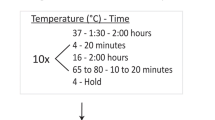Abstract
The restriction free (RF) cloning has emerged as one of the highly efficient techniques in the area of genetic engineering. RF cloning has wide range of applications in plasmid DNA manipulation including cloning of a single gene, simultaneous assembly of multiple DNA fragments, and mutagenesis from single to multiple simultaneous alterations of a target DNA. Recently, we have developed a new technique of circular permutation using RF cloning. Circular permutation is widely used to investigate the mechanisms of protein folding and function. Previously, restriction enzyme based cloning was used to introduce circular permutation. Our RF cloning method made the protocol faster and more cost-effective. In this chapter, we describe a step-by-step protocol for generating circular permutants using RF methodology.
Access this chapter
Tax calculation will be finalised at checkout
Purchases are for personal use only
Similar content being viewed by others
References
Yu Y, Lutz S (2011) Circular permutation: a different way to engineer enzyme structure and function. Trends Biotechnol 29(1):18–25
Bliven S, Prlic A (2012) Circular permutation in proteins. PLoS Comput Biol 8(3):e1002445
Baird GS, Zacharias DA, Tsien RY (1999) Circular permutation and receptor insertion within green fluorescent proteins. Proc Natl Acad Sci U S A 96(20):11241–11246
Cheltsov AV, Barber MJ, Ferreira GC (2001) Circular permutation of 5-aminolevulinate synthase. Mapping the polypeptide chain to its function. J Biol Chem 276(22):19141–19149
Graf R, Schachman HK (1996) Random circular permutation of genes and expressed polypeptide chains: application of the method to the catalytic chains of aspartate transcarbamoylase. Proc Natl Acad Sci U S A 93(21):11591–11596
Luger K et al (1989) Correct folding of circularly permuted variants of a beta alpha barrel enzyme in vivo. Science 243(4888):206–210
Luger K, Szadkowski H, Kirschner K (1990) An 8-fold beta alpha barrel protein with redundant folding possibilities. Protein Eng 3(4):249–258
Qian Z, Lutz S (2005) Improving the catalytic activity of Candida antarctica lipase B by circular permutation. J Am Chem Soc 127(39):13466–13467
Topell S, Hennecke J, Glockshuber R (1999) Circularly permuted variants of the green fluorescent protein. FEBS Lett 457(2):283–289
Celie PH, Parret AH, Perrakis A (2016) Recombinant cloning strategies for protein expression. Curr Opin Struct Biol 38:145–154
van den Ent F, Lowe J (2006) RF cloning: a restriction-free method for inserting target genes into plasmids. J Biochem Biophys Methods 67(1):67–74
Unger T et al (2010) Applications of the Restriction Free (RF) cloning procedure for molecular manipulations and protein expression. J Struct Biol 172(1):34–44
Peleg Y, Unger T (2014) Application of the restriction-free (RF) cloning for multicomponents assembly. Methods Mol Biol 1116:73–87
Bandyopadhyay B, Peleg Y (2018) Facilitating circular permutation using Restriction Free (RF) cloning. Protein Eng Des Sel 31(3):65–68
Bandyopadhyay B et al (2019) Contact order is a determinant for the dependence of GFP folding on the chaperonin GroEL. Biophys J 116(1):42–48
Erijman A et al (2011) Transfer-PCR (TPCR): a highway for DNA cloning and protein engineering. J Struct Biol 175(2):171–177
Acknowledgments
We thank Prof. Amnon Horovitz for his support. The SPU is supported by the Dana and Yossie Holander Center for Structural Proteomics.
Author information
Authors and Affiliations
Corresponding authors
Editor information
Editors and Affiliations
Rights and permissions
Copyright information
© 2022 Springer Science+Business Media, LLC, part of Springer Nature
About this protocol
Cite this protocol
Bandyopadhyay, B., Peleg, Y. (2022). Application of Restriction Free (RF) Cloning in Circular Permutation. In: Currin, A., Swainston, N. (eds) Directed Evolution. Methods in Molecular Biology, vol 2461. Humana, New York, NY. https://doi.org/10.1007/978-1-0716-2152-3_10
Download citation
DOI: https://doi.org/10.1007/978-1-0716-2152-3_10
Published:
Publisher Name: Humana, New York, NY
Print ISBN: 978-1-0716-2151-6
Online ISBN: 978-1-0716-2152-3
eBook Packages: Springer Protocols




